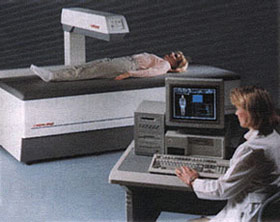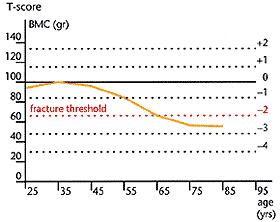Osteoporosis should be suspected in any individual who has a fracture. X-rays will usually confirm a fracture if there is one. X-rays should be done if a limb or other bone is acutely painful after a fall or injury. Sometimes individuals will have mild to severe chronic back pain, and X-rays of the thoracic or lumbar spine might detect a wedge or crush fracture (see Figure 1). Any individual with a significant fracture needs to be assessed to exclude or identify medical problems that could have played a role in the resulting fracture.
Individuals who have not had any fractures but do have a number of risk factors for osteoporosis need an examination called a bone density test to determine if osteoporosis is present.

Figure 1
A lateral X-ray of the thoracic spine (left) might reveal small wedge fractures, or of a lumbar spine (right) might reveal a more significant crush fracture.
What is a bone density test?
A bone density test determines the bone mineral (calcium) content of certain bones. It is a simple, painless procedure that can measure the calcium content of bones in specific body areas including the spine, hip, forearm, or total body. The most common bone density test used to diagnose and monitor osteoporosis is dual-energy x-ray absorptiometry (DXA).
During the DXA bone density test (see Figure 2), the individual lies perfectly still on a special table while a mechanical arm passes over the body. The mechanical arm sends an X-ray beam through the bones being scanned. A detector arm below the body determines how much of the X-ray beam passes through the body and, from that measurement, calculates how much bone is present. That calculation is then compared with the average for men and women of the same sex and age. Your doctor will discuss the results of the bone density test and help you make a decision about treatment options.

Figure 2
A DXA bone density test can be done quickly and in comfort.
The radiation risk is minimal - a single bone density test gives about one-tenth the radiation as a chest X-ray. This is the same radiation exposure as you receive flying from the east coast to the west coast of North America. Nevertheless, a woman should not have a test if she is pregnant.
It might be recommended to repeat a bone density test to make sure there is not further bone loss over time or to help evaluate if the treatment is effective. Generally a repeat bone density in 1 to 3 years is sufficient to see if there has been a significant change in bone density.

Figure 3
A T-score gives you a good idea of how strong your bones are now compared with what they were at their strongest. It does this by comparing current bone density with peak bone density. A T-score of -2.5 often indicates osteoporosis.
Who should get a bone density test to diagnose osteoporosis?
Osteoporosis Canada has set clear guidelines on deciding who should get bone density testing. It is recommended that all individuals over 65 or younger individuals with risk factors for fractures or low bone mass should receive a bone density test.
How do you interpret the results of a bone density test?
An individual's bone density result is compared with the average for individuals of the same age and sex. Your doctor will explain the results. Often, the result of the test is reported as a T-score. A T-score is a measure of your current bone density compared with what the density theoretically was at its peak (see Figure 3).
All material copyright MediResource Inc. 1996 – 2023. Terms and conditions of use. The contents herein are for informational purposes only. Always seek the advice of your physician or other qualified health provider with any questions you may have regarding a medical condition. Source: www.medbroadcast.com/healthfeature/gethealthfeature/Learn-About-Osteoporosis
